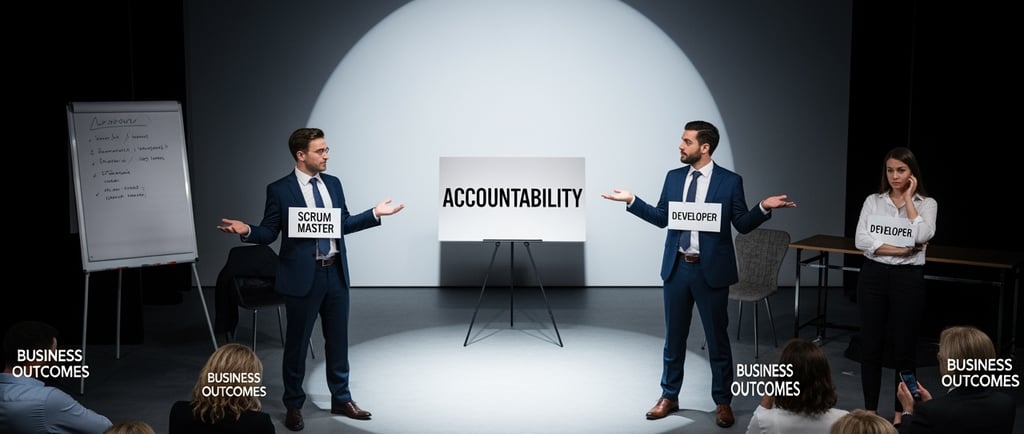Agile Theater: How Full-Time Scrum Masters and Process Managers Are Killing Accountability (and What to Do Instead)
Ever sat through a stand-up that felt more like a hostage situation than a team sync? You’re not alone. Agile was supposed to empower teams and accelerate delivery. Instead, in too many orgs, it’s devolved into a ritual—run by people who don’t actually build anything.
8/8/20254 min read


Ever sat through a stand-up that felt more like a hostage situation than a team sync? You’re not alone. Agile was supposed to empower teams and accelerate delivery. Instead, in too many orgs, it’s devolved into a ritual—run by people who don’t actually build anything.
Here’s my hot take: hiring full-time Scrum Masters or process managers often undermines technical accountability, slows delivery, and creates a leadership vacuum. Let’s talk about why—and what better looks like.
What Agile Was Supposed to Be
Remember the Agile Manifesto?
Individuals and interactions over processes and tools
Working software over comprehensive documentation
Customer collaboration over contract negotiation
Responding to change over following a plan
Agile was designed to empower teams and deliver business value—not create new layers of bureaucracy or process for its own sake.
Organizational Design: The Real Backdrop
When it comes to org design, I’ve seen two main models up close:
General Management/Tree Structure (Amazon style):
All functions roll up to a single manager. Dev managers own delivery, people, and project management. Decisions are quick, ownership is clear, and accountability is embedded.
Matrix Structure (modern tech orgs):
Each discipline (engineering, product, design, QA) reports up to its functional leader. In theory, this fosters specialization and collaboration. In reality, you often end up with “everyone owns it, so nobody owns it.” Decision-making stalls, and accountability is diffused.
But here’s the thing: most successful organizations don’t live at either extreme. The real sweet spot is a hybrid—where you get the clarity and speed of the tree structure, but also benefit from the specialization and peer support of the matrix. The best orgs blend both, ensuring clear technical and delivery ownership while still leveraging functional expertise.
The problem? When you lean too hard into the matrix—especially by making Scrum Masters or process managers the central node—you lose that balance. That’s when accountability starts to evaporate, and the wheels come off.
The Problem With Full-Time Scrum Masters/Process Managers
A common pattern: some orgs skip having a dev manager entirely, letting a Scrum Master “run the team.” On paper, this looks efficient. In practice, it leaves a massive hole in leadership and accountability.
No clear owner for delivery or technical quality
Team members don’t know who can make real decisions
Accountability is diffused—when things go wrong, it’s a game of “not my job”
The Scrum Master becomes an information broker, not a true leader
Now, I can already hear the agile apologists:
“Well, that’s not how it’s supposed to work. If you get everyone together, follow the framework, and foster the right culture, it works beautifully.”
And sure, maybe in the textbook world or with the top five percent of unicorn teams, that’s true. But let’s be honest—most organizations aren’t operating in a fantasyland. In reality, this model is optimizing for failure. It assumes perfect alignment and shared ownership will just happen, when all it really does is create confusion, diffuse accountability, and slow everything down. For the vast majority of teams, you end up with process for process’s sake, and nobody actually driving results.
Warning Signs You’re in Agile Theater
Stand-ups take longer than coding sessions.
Stand-ups devolve into quick status updates—no real problem-solving, no accountability, just “process for process’s sake.”
No dev manager: The team reports to a Scrum Master who can’t make technical or delivery decisions.
Leadership is split: Scrum Masters and product owners point at each other when things go wrong.
More discussion about process than about product or customers.
No clear technical owner for deliverables.
Teams “optimize” for velocity metrics, not for delivering real value.
What Real Agile Leadership Looks Like
Technical managers/leads own delivery, quality, and process.
Agile is a mindset and toolset, not a job title.
Teams are empowered to adapt, not just follow rituals.
Examples:
Amazon’s streamlined “two pizza teams”—small, autonomous groups with a clear owner who is accountable for delivery and technical decisions.
Spotify’s original squads (before process overload).
Basecamp’s “manager of one” philosophy.
Research & Industry Voices
Scrum:
The Scrum Master is intended to be a facilitator—a function that someone on the team can play to help remove blockers and keep the process running smoothly. But crucially, the Scrum Master is not supposed to be the ultimate owner of delivery. That responsibility always resides with the specialists actually doing the work—engineering. When organizations misunderstand this and turn Scrum Master into a full-time, process-only role, they remove accountability from those who actually deliver value.Kanban & XP:
No Scrum Master role; focus is on flow, technical leadership, and team accountability.Thought leaders:
Martin Fowler: “You can’t buy agility; you have to grow it.”
Kent Beck: Emphasizes technical excellence and team ownership over process.
Studies:
Teams with technical leadership and clear ownership consistently outperform those with only process managers, as shown in the DORA State of DevOps Report (Google Cloud):
https://cloud.google.com/devops/state-of-devops
What To Do Instead
Hire technical leaders, not process managers.
Make accountability for delivery clear—don’t outsource it to a facilitator.
Use agile ceremonies as tools, not ends in themselves.
Practical steps:
Give engineers and leads real ownership over process and outcomes.
Limit process overhead; focus on what actually moves the needle.
Regularly review whether ceremonies add value—or just fill the calendar.
Conclusion / Call to Action
If you want faster delivery, higher quality, and a happier team, stop outsourcing accountability to process managers. Invest in real technical leadership.
If your org feels stuck in Agile Theater, Foundry Fractional can help you design teams that actually deliver. Let’s talk about what real, accountable work design looks like—and how it can help you scale with confidence.
Appendix: Industry Sources & Further Reading
DORA State of DevOps Report (Google Cloud):
Annual, data-driven research showing that teams with strong technical leadership and ownership dramatically outperform those focused on process management alone.
https://cloud.google.com/devops/state-of-devopsAccelerate: The Science of Lean Software and DevOps
By Nicole Forsgren, Jez Humble, and Gene Kim. The foundational book behind the DORA research—explores metrics, leadership, and organizational design for high-performing teams.Agile Manifesto:
The original values and principles that inspired agile methodologies.
https://agilemanifesto.org/Martin Fowler – “You can’t buy agility; you have to grow it.”
https://martinfowler.com/articles/agileAgility.htmlKent Beck – On Technical Excellence and Team Ownership:
https://www.kentbeck.com/Spotify Engineering Culture (original squads model):
https://engineering.atspotify.com/2014/03/27/spotify-engineering-culture-part-1/
There for the hurry not the wait
matt@foundryfractional.com
+1-206-480-8525
© 2025. Foundry Fractional. All rights reserved. Functional Technology TM & Copyright © 2024 CTOx LLC. All rights reserved.
